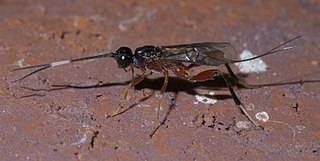
The Braconidae are a family of parasitoid wasps. After the closely related Ichneumonidae, braconids make up the second-largest family in the order Hymenoptera, with about 17,000 recognized species and many thousands more undescribed. One analysis estimated a total between 30,000 and 50,000, and another provided a narrower estimate between 42,000 and 43,000 species.

Trigonalidae is a family of parasitic wasps in the suborder Apocrita. They are the only living members of the superfamily Trigonaloidea. Trigonalidae are divided into 2 subfamilies; Orthogonalinae and Trigonalinae. These wasps are extremely rare, but surprisingly diverse, with over 90 species in 16 genera, and are known from all parts of the world. It is possibly the sister group to all Aculeata.

The Stephanidae, sometimes called crown wasps, are a family of parasitoid wasps. They are the only living members of the superfamily Stephanoidea. Stephanidae has at least 345 living species in 11 genera. The family is considered cosmopolitan in distribution, with the highest species concentrations in subtropical and moderate climate zones. Stephanidae also contain four extinct genera described from both compression fossils and inclusions in amber.

The Rijksmuseum van Natuurlijke Historie was a museum on the Rapenburg in Leiden, the Netherlands. It was founded in 1820 by Royal Decree from a merger of several existing collections including Temminck's own collection. This happened on the initiative of Coenraad Jacob Temminck, who saw the museum primarily as a research institute for the University of Leiden. The total collection was already quite large at the time, and continued to grow from foreign expeditions and by obtaining private collections from inheritances. The location is currently used by the Rijksmuseum van Oudheden.

Acaenitinae is a subfamily of the parasitoid wasp family Ichneumonidae. Female Acaenitinae have a large triangular projecting genital plate.

Microgastrinae is a subfamily of braconid wasps, encompassing almost 3,000 described species, with an estimated 30,000–50,000 total species. This makes it one of the richest subfamilies with the most species of parasitoid wasps.

Agathidinae is a subfamily of braconid parasitoid wasps. Some species have been used in biological control programs.

The Doryctinae or doryctine wasps are a large subfamily of parasitoid wasps within the family Braconidae.
Protostephanus is an extinct genus of crown wasp in the Hymenoptera family Stephanidae known from an Eocene fossil found in the United States of America. The genus contains a single described species, Protostephanus ashmeadi placed in the stephanid subfamily Stephaninae.
Nyereria is a genus of braconid wasps in the family Braconidae. There are around 30 described species in Nyereria. Most species are found in Africa, a few in Asia.
Labus is an Indomalayan genus of potter wasps. It contains the following species:

The Thynnidae are a family of large, solitary wasps whose larvae are almost universally parasitoids of various beetle larvae, especially those in the superfamily Scarabaeoidea. Until recently, the constituents of this family were classified in the family Tiphiidae, but multiple studies have independently confirmed that thynnids are a separate lineage.

Helorus is a genus of wasps in the family Heloridae. There are about 12 described species in Helorus, found worldwide Members of the genus are parasitic on green lacewings. The oldest fossils are from Eocene aged Baltic amber.

Brachistinae is a subfamily of braconid wasps in the family Braconidae.

Helconinae is a subfamily of braconid wasps in the family Braconidae.

Aulacus is a genus of aulacids, ensigns, and gasteruptiids in the family Aulacidae. There are 77 species of Aulacus.

Stephanus serrator is a species of parasitic wasp in the family Stephanidae, the crown wasps. This species is native to much of Europe and is to be seen in the breeding season on recently dead timber or wood products. The larvae are parasitoids of the larvae of wood-boring beetles.
The Acampsohelconinae are a subfamily of braconid parasitoid wasps. Extant members of this subfamily were previously included in the Helconinae, Blacinae, or Sigalphinae. The four genera included are †Acampsohelcon, Afrocampsis, Canalicephalus, and Urosigalphus.
Jouault, Corentin; Rosse-Guillevic, Simon. "A new genus of praeaulacid wasp from the mid-Cretaceous Kachin amber (Myanmar)". Annales de Paléontologie. 109 (1): 102599. doi:10.1016/j.annpal.2023.102599.

Megischus is a genus of crown-wasps in the parasitoid family Stephanidae. There are over 90 species globally distributed throughout the Neotropical, Palearctic, Afrotropical, Oriental, Australasian, and Oceanian zoogeographical regions.














